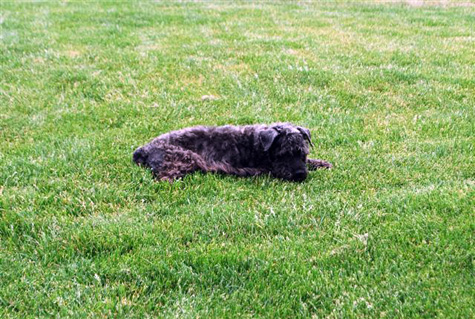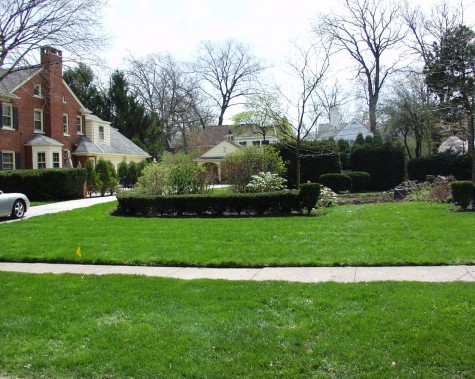
Eight years ago a client came in with a plan to renovate the side lot adjoining his 1920’s vintage house. This part of his landscape had been a series of free flowing beds of flowering shrubs and perennials, edged in a volcanic rock I call Castelia stone. Named for the town in Ohio where it occurs naturally, I see this stone in fountains, etc, at homes of this period.

The land dropped dramatically from the grade of the existing driveway.The plan called for hauling away all of the Castelia stone, and installing a terrace of concrete pavers. Alarmed by this, he thought a second opinion might be in order. The stone was no doubt spectacular, and there was a lot of it.
The design issue of the day? How could that stone be featured in a landscape that would be beautiful and appropriate to the house.? After hauling away ten yards of debris from overgrown shrubs and scrub trees, it became apparent that stone could be the key to solving the grade issues.
The land was a giant dish, bordered by my client’s drive, and his neighbors drive. This stark view to the neighboring home was the dominant visual element. I told my client I thought a formal sunken garden would be in order-an idea in which the existing stone would play a prominent role. Sinking the garden down 20″ would also make the job of screening the neighboring house easier.

An old flight of steps, now blocked by a yew of great age, had been the only access to this area of the garden. The decision was made to orient the new sunken garden around a side terrace adjoining the house, and plans were made to allow for good access to the space.
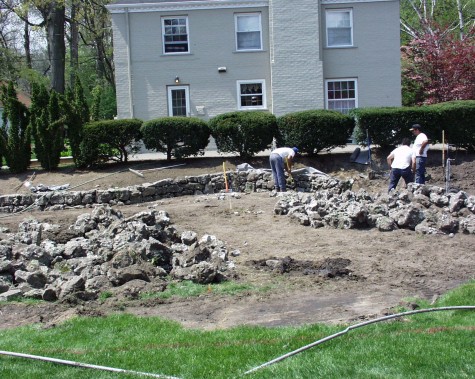
It is one thing to use materials that existed in an old landscape; it is another thing to use it in such a way that it appears to have always been there. The client was interested that the new landscape seem like it had been built on top of the old one. We transplanted a row of old yews that had been a foundation planting across the front of the house to the lot line adjoining the neighboring house. We then sloped the soil down to a 20″ tall retaining wall of the old stone.
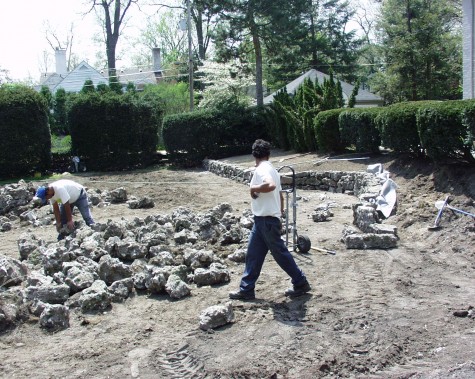
Each stone was fitted into the wall by hand and by eye. The use of any power tools to force a fit would have interfered with the illusion of age. The evidence of modern tools would have immediately dated the wall as a contemporary construction.

The ground was graded and regraded; soil was brought in to fill areas that were low; the ground plane was topdressed with topsoil in anticipation of the lawn.
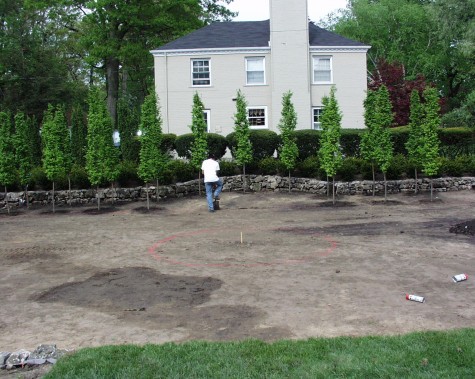
Densiformis yews were planted solidly on the slope down from the neighboring drive. This gave the background landscape a bit of a contemporary feeling. The French word bosquet refers to a densely planted block of trees, which when grown in, provides an architectural element similar to a pergola. These 25 gallon potted columnar carpinus planted as such would make an allee across the back of the garden, and would eventually screen the house next door.

It was decided that a fountain, whose basin would be faced the in the same volcanic rock, would anchor the space.

Edger strip was installed, and decomposed granite provided a hard surface under the bosquet. This treatment also formalized the edges of the lawn panel to come, and celebrated the irregular surfaces of the stone.
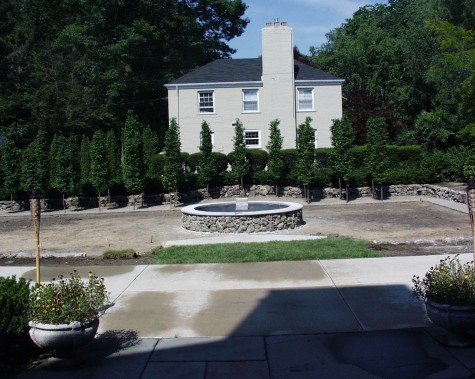
The radius of the fountain dictated the radius of the center of the bosquet. The center would have room for garden furniture.
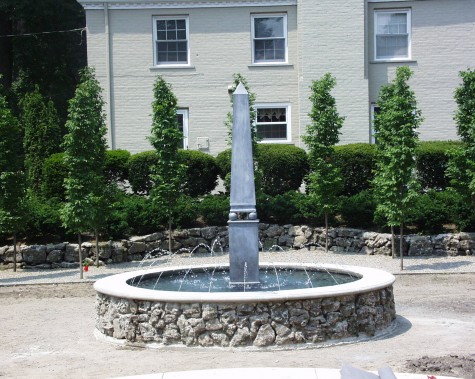
A contemporary European lead obelisk is a striking contrast to the stone. A lawn panel is all that is missing now.
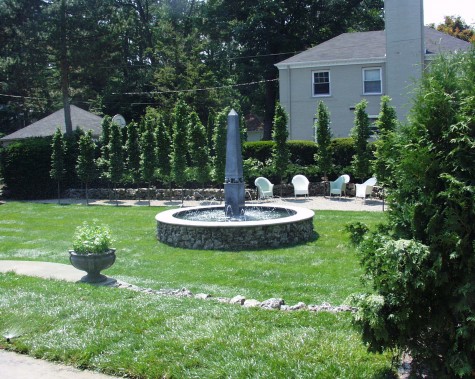
The resulting landscape is a great place to view whatever the weather, and a great place to entertain. Its composition makes much of the relationship of old materials, and my client’s more contemporary design sensibility.

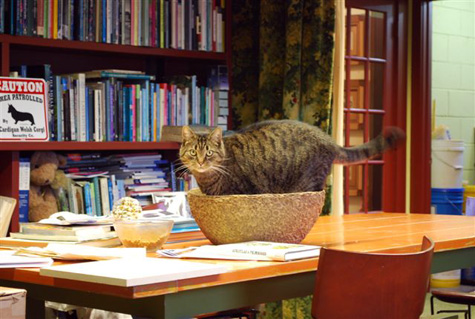
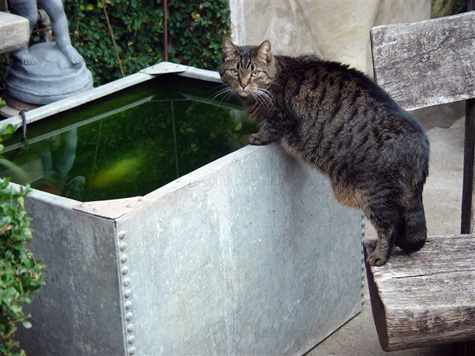
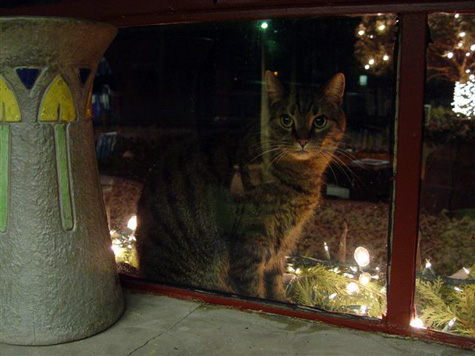

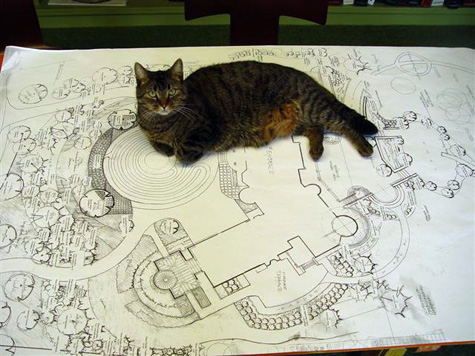
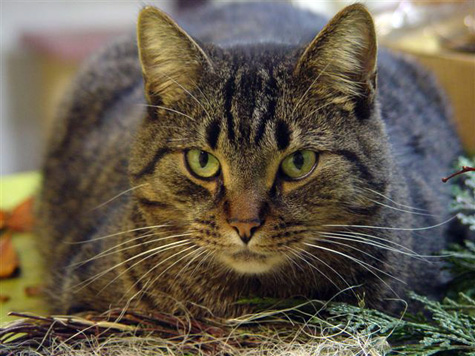 Though I posted a few weeks ago that the loss of Rob’s schnauzer Libby was the end of an era, that assessment was more about my grief than the truth. Eras overlap. Though she is gone, I have a group of three who this minute delight me. I have many plants still in my garden that date back to my purchase of my house and property 15 years ago. MCat, Milo and Howard shared the space with the schnauzers-how they loved Libby at the last-and how this irritated her. She kept that irritation up start to finish. These three never gave up, hoping she would fall for them. Is this not a story every life has in some version or another? I have old plants in my garden that were no doubt irritated, buffeted by my ownership. The big idea here-eras overlap. Keep the old friends in your garden as long as you can. Welcome your new friends, and move on. Its a new era.
Though I posted a few weeks ago that the loss of Rob’s schnauzer Libby was the end of an era, that assessment was more about my grief than the truth. Eras overlap. Though she is gone, I have a group of three who this minute delight me. I have many plants still in my garden that date back to my purchase of my house and property 15 years ago. MCat, Milo and Howard shared the space with the schnauzers-how they loved Libby at the last-and how this irritated her. She kept that irritation up start to finish. These three never gave up, hoping she would fall for them. Is this not a story every life has in some version or another? I have old plants in my garden that were no doubt irritated, buffeted by my ownership. The big idea here-eras overlap. Keep the old friends in your garden as long as you can. Welcome your new friends, and move on. Its a new era.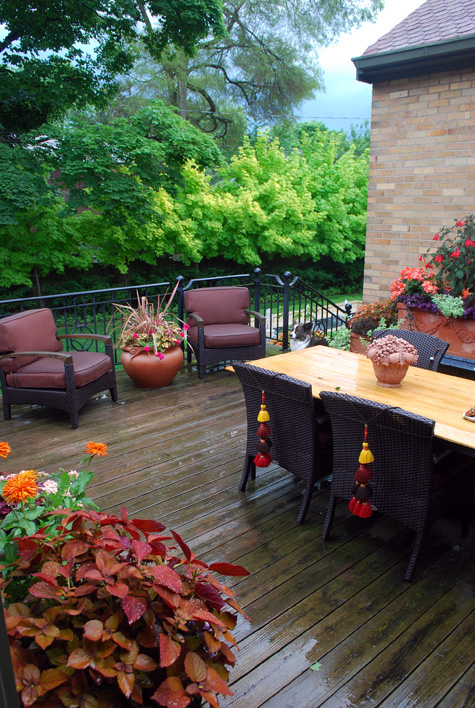
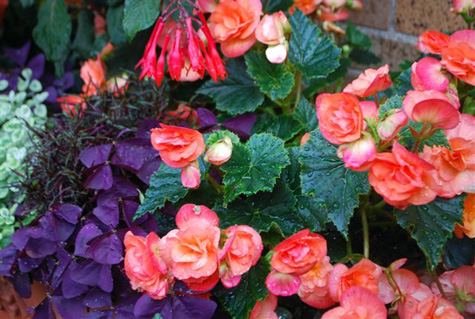
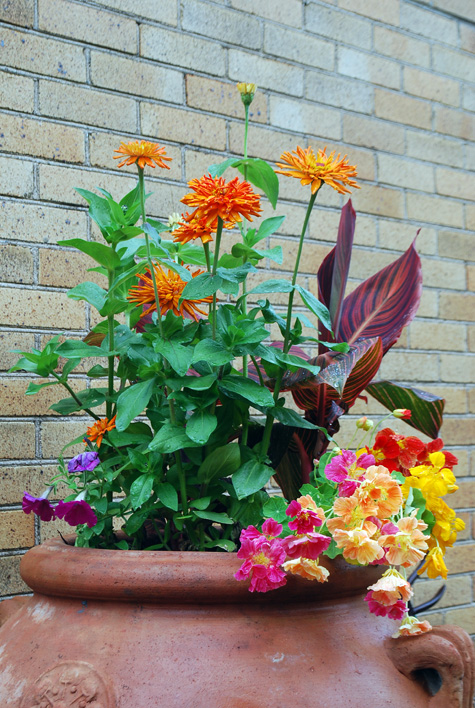
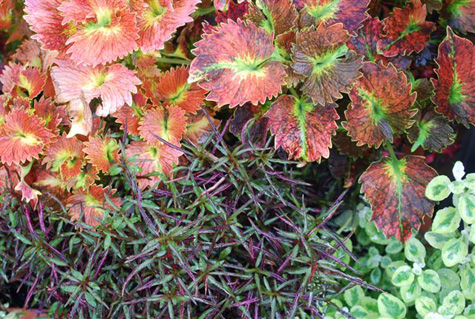

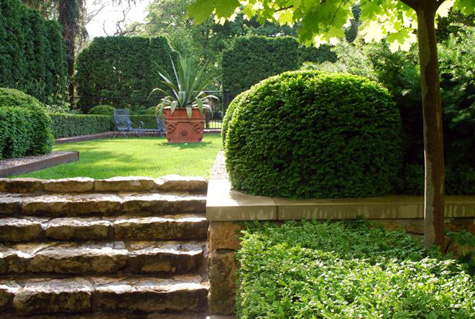

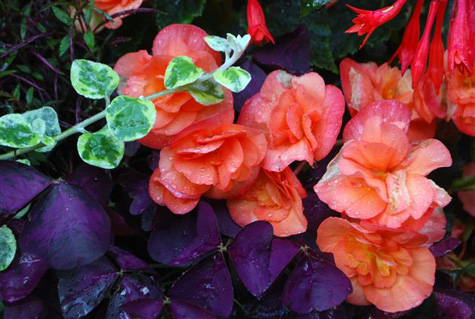

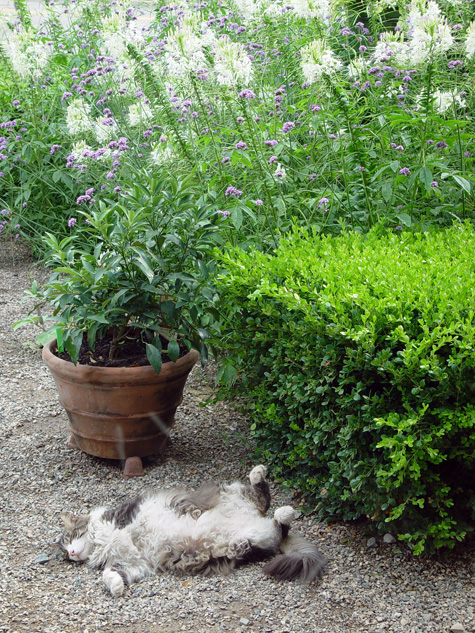 Gardeners seem to welcome every kind of life into their own. Well, ok, maybe not snails, Japanese beetles, deer, aphids and woodchucks-who loves these creatures? A gardener”s distaste for certain pests doesn’t necessarily result in weapons; many gardeners tolerate the wildlife, as we have to share our planet. But some creatures live in our gardens, and our lives, by invitation. We do a good job, looking after them, and they reward us with their unconditional love and friendship. My Jojo (formally known as George) so enriched my life. He appeared at my front door one day from a home across the street that he apparently did not like, and never left. He suffered children, carrying him around in his favorite brown paper bag. He bossed around any dog that came to visit. He lived to be 22; I lost him too soon.
Gardeners seem to welcome every kind of life into their own. Well, ok, maybe not snails, Japanese beetles, deer, aphids and woodchucks-who loves these creatures? A gardener”s distaste for certain pests doesn’t necessarily result in weapons; many gardeners tolerate the wildlife, as we have to share our planet. But some creatures live in our gardens, and our lives, by invitation. We do a good job, looking after them, and they reward us with their unconditional love and friendship. My Jojo (formally known as George) so enriched my life. He appeared at my front door one day from a home across the street that he apparently did not like, and never left. He suffered children, carrying him around in his favorite brown paper bag. He bossed around any dog that came to visit. He lived to be 22; I lost him too soon.
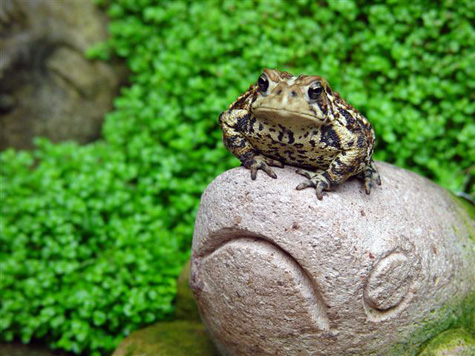
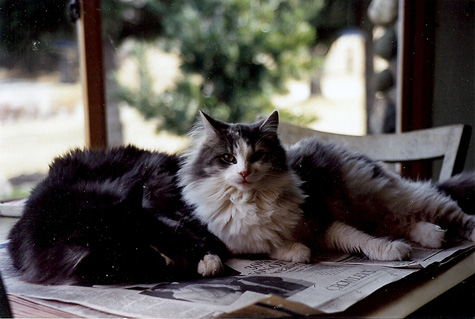 Victor and Agnes were at home in the garden, but their favorite places were my drafting table, any open drawer, or anyplace I had the New York Times spread out. I inherited her along with the house and 5 acres I bought-she was the best part of the deal. Victor I did not have long, but my memory of him has been long.
Victor and Agnes were at home in the garden, but their favorite places were my drafting table, any open drawer, or anyplace I had the New York Times spread out. I inherited her along with the house and 5 acres I bought-she was the best part of the deal. Victor I did not have long, but my memory of him has been long.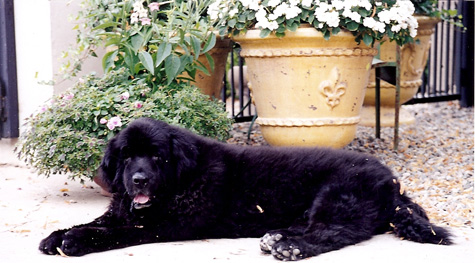 Cosmo was as fine a dog as ever was. He lived to be 14, and was a fixture at the store for the last 7 years of his life. Kids loved him; I watched a child lean over into his face-and blink his eyes open and shut three times. “Do this, if you love me”, he said; he insisted to his Mom that Cosmo blinked at him. This I choose to believe. People still come in and ask for him. The last few years he actually lived at the store. Though he was deaf by then, he would start barking when my car would pull up in the morning-how did he know?
Cosmo was as fine a dog as ever was. He lived to be 14, and was a fixture at the store for the last 7 years of his life. Kids loved him; I watched a child lean over into his face-and blink his eyes open and shut three times. “Do this, if you love me”, he said; he insisted to his Mom that Cosmo blinked at him. This I choose to believe. People still come in and ask for him. The last few years he actually lived at the store. Though he was deaf by then, he would start barking when my car would pull up in the morning-how did he know? These creatures have been much a part of my gardening life, each one of them, a part of my landscape. Each of them had strikingly different personalities, but they shared the space well with me, and with each other.
These creatures have been much a part of my gardening life, each one of them, a part of my landscape. Each of them had strikingly different personalities, but they shared the space well with me, and with each other.
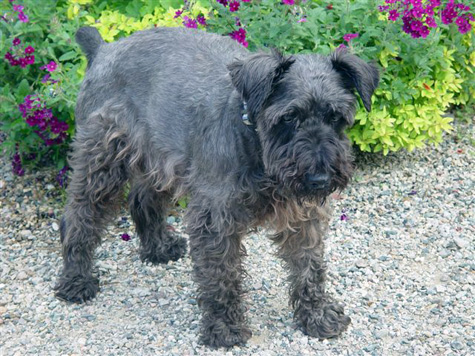 Jack and Libby belonged to Rob. I thought to surprise Rob with a gift of a mini-schnauzer; no, he wanted two schnauzers. So fine, 2 schnauzers it was-brother and sister, the only two in the litter. Those two dogs were never far from Rob for the better part of 15 years. They grew up in the back of my work truck, and graduated to retail store duty in 1996. Until May of 2008; Jack was almost 14.
Jack and Libby belonged to Rob. I thought to surprise Rob with a gift of a mini-schnauzer; no, he wanted two schnauzers. So fine, 2 schnauzers it was-brother and sister, the only two in the litter. Those two dogs were never far from Rob for the better part of 15 years. They grew up in the back of my work truck, and graduated to retail store duty in 1996. Until May of 2008; Jack was almost 14.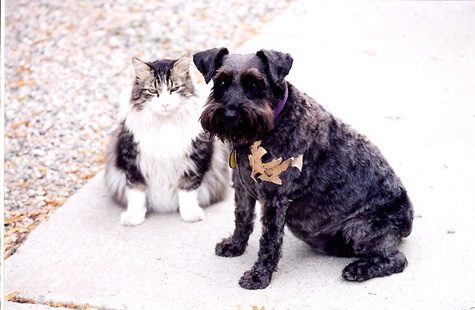 Libby was the last of a group that spanned some 24 years of my life. I think the last year she spent without Jack was tough, but Rob loved her up plenty and she loved Rob fiercely in return. The last 6 months of her life she mostly slept on a bed next to my chair in my office; I knew I did not have long with her. She was the last of a very fine group; her passing is the end of an era. Libby Yedinak, Sept 1994-June 2009. No matter the grief, I was very lucky indeed to have each and all of them. Any gardener knows that to everything there is a season, and the seasons turn sooner or later. But knowing this does not make it much easier; how I loved them all, and how I miss them.
Libby was the last of a group that spanned some 24 years of my life. I think the last year she spent without Jack was tough, but Rob loved her up plenty and she loved Rob fiercely in return. The last 6 months of her life she mostly slept on a bed next to my chair in my office; I knew I did not have long with her. She was the last of a very fine group; her passing is the end of an era. Libby Yedinak, Sept 1994-June 2009. No matter the grief, I was very lucky indeed to have each and all of them. Any gardener knows that to everything there is a season, and the seasons turn sooner or later. But knowing this does not make it much easier; how I loved them all, and how I miss them.